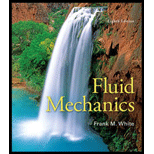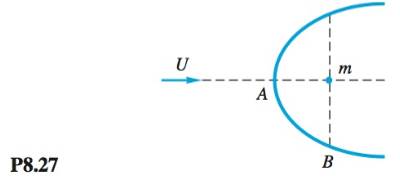
Fluid Mechanics
8th Edition
ISBN: 9780073398273
Author: Frank M. White
Publisher: McGraw-Hill Education
expand_more
expand_more
format_list_bulleted
Concept explainers
Textbook Question
Chapter 8, Problem 8.28P
Sources of equal strength m are placed at the four symmetric positions

Expert Solution & Answer
Want to see the full answer?
Check out a sample textbook solution
Students have asked these similar questions
Sources of equal strength m are placed at the four symmetricpositions (x, y) = (a, a), (-a, a), (-a, -a), and (a, -a).Sketch the streamline and potential line patterns. Do anyplane “walls” appear?
4.12. Show that the pattern due to a two-dimensional sink at the origin
and sources at (0-5, 0) and (2, 0), all of strength 27, represents flow due to a
source near a cylinder.
Using angle measurements from a scale drawing, evaluate y for a series of
points in the first and second quadrants and, by interpolation, draw the
37
streamlines =, and
4
!3!
Problem 1
Given a steady flow, where the velocity is described by:
u = 3 cos(x) + 2ry
v = 3 sin(y) + 2?y
!!
!!
a) Find the stream function if it exists.
b) Find the potential function if it exists.
c) For a square with opposite diagonal corners at (0,0) and (47, 27), evaluate the circu-
lation I = - f V.ds where c is a closed path around the square.
d) Calculate the substantial derivative of velocity at the center of the same box.
Chapter 8 Solutions
Fluid Mechanics
Ch. 8 - Prob. 8.1PCh. 8 - The steady plane flow in Fig. P8.2 has the polar...Ch. 8 - P8.3 Using cartesian coordinates, show that each...Ch. 8 - P8.4 Is the function 1/r a legitimate velocity...Ch. 8 - Prob. 8.5PCh. 8 - An incompressible plane flow has the velocity...Ch. 8 - Prob. 8.7PCh. 8 - For the velocity distribution u=By,=+Bx , evaluate...Ch. 8 - Prob. 8.9PCh. 8 - Prob. 8.10P
Ch. 8 - Prob. 8.11PCh. 8 - Prob. 8.12PCh. 8 - P8.13 Starting at the stagnation point in Fig....Ch. 8 - P8.14 A tornado may be modeled as the circulating...Ch. 8 - Hurricane Sandy, which hit the New Jersey coast on...Ch. 8 - Prob. 8.16PCh. 8 - P8.17 Find the position (x, y) on the upper...Ch. 8 - Prob. 8.18PCh. 8 - Prob. 8.19PCh. 8 - Plot the streamlines of the flow due to a line...Ch. 8 - P8.21 At point A in Fig. P8.21 is a clockwise line...Ch. 8 - P8.22 Consider inviscid stagnation flow, (see...Ch. 8 - P8.23 Sources of strength m = 10 m2/s are placed...Ch. 8 - P8.24 Line sources of equal strength m = Ua, where...Ch. 8 - Prob. 8.25PCh. 8 - Prob. 8.26PCh. 8 - Prob. 8.27PCh. 8 - Sources of equal strength m are placed at the four...Ch. 8 - Prob. 8.29PCh. 8 - Prob. 8.30PCh. 8 - A Rankine half-body is formed as shown in Fig....Ch. 8 - Prob. 8.32PCh. 8 - P8.33 Sketch the streamlines, especially the body...Ch. 8 - Prob. 8.34PCh. 8 - Prob. 8.35PCh. 8 - Prob. 8.36PCh. 8 - Prob. 8.37PCh. 8 - Consider potential flow of a uniform stream in the...Ch. 8 - A large Rankine oval, with a = 1 m and h = 1 m, is...Ch. 8 - Prob. 8.40PCh. 8 - Prob. 8.41PCh. 8 - Prob. 8.42PCh. 8 - P8.43 Water at 20°C flows past a 1-rn-diameter...Ch. 8 - Prob. 8.44PCh. 8 - Prob. 8.45PCh. 8 - P8.46 A cylinder is formed by bolting two...Ch. 8 - Prob. 8.47PCh. 8 - Prob. 8.48PCh. 8 - Prob. 8.49PCh. 8 - It is desired to simulate flow past a...Ch. 8 - Prob. 8.51PCh. 8 -
P8.52 The Flettner rotor sailboat in Fig. E8.3...Ch. 8 - P8.52 The Flettner rotor sailboat in Fig. E8.3 has...Ch. 8 - Prob. 8.54PCh. 8 - Prob. 8.55PCh. 8 - Prob. 8.56PCh. 8 - Prob. 8.57PCh. 8 - Prob. 8.58PCh. 8 - Prob. 8.59PCh. 8 - Prob. 8.60PCh. 8 - Prob. 8.61PCh. 8 - Prob. 8.62PCh. 8 - The superposition in Prob. P8.62 leads to...Ch. 8 - Consider the polar-coordinate stream function...Ch. 8 - Prob. 8.65PCh. 8 - Prob. 8.66PCh. 8 - Prob. 8.67PCh. 8 - Prob. 8.68PCh. 8 - Prob. 8.69PCh. 8 - Prob. 8.70PCh. 8 - Prob. 8.71PCh. 8 - Prob. 8.72PCh. 8 - Prob. 8.73PCh. 8 - Prob. 8.74PCh. 8 - Prob. 8.75PCh. 8 - Prob. 8.76PCh. 8 - Prob. 8.77PCh. 8 - Prob. 8.78PCh. 8 - Prob. 8.79PCh. 8 - Prob. 8.80PCh. 8 - Prob. 8.81PCh. 8 - Prob. 8.82PCh. 8 - Prob. 8.83PCh. 8 - Prob. 8.84PCh. 8 - Prob. 8.85PCh. 8 - Prob. 8.86PCh. 8 - Prob. 8.87PCh. 8 - Prob. 8.88PCh. 8 - Prob. 8.89PCh. 8 - NASA is developing a swing-wing airplane called...Ch. 8 - Prob. 8.91PCh. 8 - Prob. 8.92PCh. 8 - Prob. 8.93PCh. 8 - Prob. 8.94PCh. 8 - Prob. 8.95PCh. 8 - Prob. 8.96PCh. 8 - Prob. 8.97PCh. 8 - Prob. 8.98PCh. 8 - Prob. 8.99PCh. 8 - Prob. 8.100PCh. 8 - Prob. 8.101PCh. 8 - Prob. 8.102PCh. 8 - Prob. 8.103PCh. 8 - Prob. 8.104PCh. 8 - Prob. 8.105PCh. 8 - Prob. 8.106PCh. 8 - Prob. 8.107PCh. 8 - P8.108 Consider two-dimensional potential flow...Ch. 8 - Prob. 8.109PCh. 8 - Prob. 8.110PCh. 8 - Prob. 8.111PCh. 8 - Prob. 8.112PCh. 8 - Prob. 8.113PCh. 8 - Prob. 8.114PCh. 8 - Prob. 8.115PCh. 8 - Prob. 8.1WPCh. 8 - Prob. 8.2WPCh. 8 - Prob. 8.3WPCh. 8 - Prob. 8.4WPCh. 8 - Prob. 8.5WPCh. 8 - Prob. 8.6WPCh. 8 - Prob. 8.7WPCh. 8 - Prob. 8.1CPCh. 8 - Prob. 8.2CPCh. 8 - Prob. 8.3CPCh. 8 - Prob. 8.4CPCh. 8 - Prob. 8.5CPCh. 8 - Prob. 8.6CPCh. 8 - Prob. 8.7CPCh. 8 - Prob. 8.1DPCh. 8 - Prob. 8.2DPCh. 8 - Prob. 8.3DP
Knowledge Booster
Learn more about
Need a deep-dive on the concept behind this application? Look no further. Learn more about this topic, mechanical-engineering and related others by exploring similar questions and additional content below.Similar questions
- Question 4. The stream function is given as y=x²-y³. a. Is this flow possible? b. Is the flow potential. If it is potential find the potential function.arrow_forward(a) A two-dimensional flow field is given byu = 5x 2 − 5y 2v = −10xy(i) Find the streamfunction ψ and velocity potential φ.(ii) Find the equation for the streamline and potential line which passesthrough the point (1, 1).arrow_forward2. The velocity field of a flow in cylindrical coordinates (r, 0, z) is Ur = 0, ug = arz, u, = 0 where a is a constant. a. Find the vorticity components. b. Verify that V.w = :0. c. Determine the streamlines and the vortex lines and plot them in an r-z plane.arrow_forward
- At t = 0, an unstable velocity field V = xy²ti + zxj – t³k, emerges in the 3D plane as a result of a streamline passing through the points (3, -1, 2). Determine the equation that can act for the streamline.arrow_forwardvelocity field is given by: A two-dimensional V = (x - 2y) i- (2x + y)Ĵj a. Show that the flow is incompressible and irrotational. b. Derive the expression for the velocity potential, (x,y). c. Derive the expression for the stream function, 4(x,y).arrow_forwardfor the following flows, find the equation of the streamline through(1,1). v= -y^(2)i-6xjarrow_forward
- (c) A flow field consists of two free vortices which are rotating in clockwise direction with the strengths, K of 20 m²/s and 15 m/s located at points A(3, 3) and B(-4,-4) respectively. Sketch the whole flow field and indicate all the points (A, B, C and stagnation (i) point(s), note that point C (-4,0) is given in part (iii)) and velocities involved clearly. (ii) Find the stagnation point or points of this flow field and indicate the coordinate or coordinates clearly. (iii) Find the resultant velocity (both magnitude and angle with x-axis) at point C(-4, 0). K Note: For free vortex, the velocity components are v, = 0 and v, ==. rarrow_forward1. Find the equation of a streamline that passes through the point P(1, 4, -2) in the field E=2e5x[y(5x+1)ax+xay]E=2e5x[y(5x+1)ax+xay].arrow_forward3. An unsteady velocity field V = xy'ti + zxj – t°k exists at the 3D plane alona a streamline that passes through the point (3,-1,2) at t = 0. Find the equation representing this streamlinearrow_forward
- 3.4 The stream function in a two dimensional flow field is given by y = x² - y? The magnitude of the velocity at point (1, 1) is (a) 2 (b) 2/2 (c) 4 (d) 8arrow_forwardQuestion 3 Consider the two-dimensional incompressible velocity potential O = xy + x² – y2 a) Show that this flow is irrotational. b) Find the stream function Y(x, y), if Y(0,0) = 0 .arrow_forwardThe stream function is given by y =-4xy. Then the magnitude of velocity at point (2,4) is m/s.arrow_forward
arrow_back_ios
SEE MORE QUESTIONS
arrow_forward_ios
Recommended textbooks for you
 Elements Of ElectromagneticsMechanical EngineeringISBN:9780190698614Author:Sadiku, Matthew N. O.Publisher:Oxford University Press
Elements Of ElectromagneticsMechanical EngineeringISBN:9780190698614Author:Sadiku, Matthew N. O.Publisher:Oxford University Press Mechanics of Materials (10th Edition)Mechanical EngineeringISBN:9780134319650Author:Russell C. HibbelerPublisher:PEARSON
Mechanics of Materials (10th Edition)Mechanical EngineeringISBN:9780134319650Author:Russell C. HibbelerPublisher:PEARSON Thermodynamics: An Engineering ApproachMechanical EngineeringISBN:9781259822674Author:Yunus A. Cengel Dr., Michael A. BolesPublisher:McGraw-Hill Education
Thermodynamics: An Engineering ApproachMechanical EngineeringISBN:9781259822674Author:Yunus A. Cengel Dr., Michael A. BolesPublisher:McGraw-Hill Education Control Systems EngineeringMechanical EngineeringISBN:9781118170519Author:Norman S. NisePublisher:WILEY
Control Systems EngineeringMechanical EngineeringISBN:9781118170519Author:Norman S. NisePublisher:WILEY Mechanics of Materials (MindTap Course List)Mechanical EngineeringISBN:9781337093347Author:Barry J. Goodno, James M. GerePublisher:Cengage Learning
Mechanics of Materials (MindTap Course List)Mechanical EngineeringISBN:9781337093347Author:Barry J. Goodno, James M. GerePublisher:Cengage Learning Engineering Mechanics: StaticsMechanical EngineeringISBN:9781118807330Author:James L. Meriam, L. G. Kraige, J. N. BoltonPublisher:WILEY
Engineering Mechanics: StaticsMechanical EngineeringISBN:9781118807330Author:James L. Meriam, L. G. Kraige, J. N. BoltonPublisher:WILEY

Elements Of Electromagnetics
Mechanical Engineering
ISBN:9780190698614
Author:Sadiku, Matthew N. O.
Publisher:Oxford University Press

Mechanics of Materials (10th Edition)
Mechanical Engineering
ISBN:9780134319650
Author:Russell C. Hibbeler
Publisher:PEARSON

Thermodynamics: An Engineering Approach
Mechanical Engineering
ISBN:9781259822674
Author:Yunus A. Cengel Dr., Michael A. Boles
Publisher:McGraw-Hill Education

Control Systems Engineering
Mechanical Engineering
ISBN:9781118170519
Author:Norman S. Nise
Publisher:WILEY

Mechanics of Materials (MindTap Course List)
Mechanical Engineering
ISBN:9781337093347
Author:Barry J. Goodno, James M. Gere
Publisher:Cengage Learning

Engineering Mechanics: Statics
Mechanical Engineering
ISBN:9781118807330
Author:James L. Meriam, L. G. Kraige, J. N. Bolton
Publisher:WILEY
Introduction to Kinematics; Author: LearnChemE;https://www.youtube.com/watch?v=bV0XPz-mg2s;License: Standard youtube license